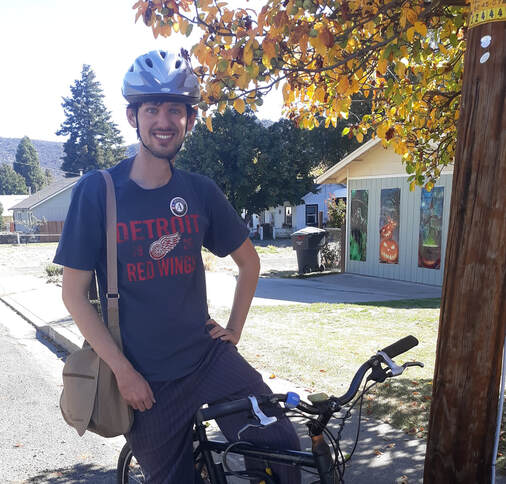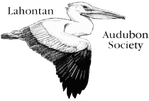 The author on his bicycle. The author on his bicycle. Written by Parker Flickinger Author's note: This article is an account of a birdwatching challenge. During this challenge, I followed the concept of “mindful birdwatching” etiquette. This etiquette includes avoiding private property, public area closures, and sensitive bird habitat. It also includes following the pandemic social distancing rules. To visit some of the locations mentioned in this article, I had to receive prior permission. I highly recommend you review mindful birdwatching etiquette before getting started. Click here to learn more about mindful birdwatching . As you are well aware, I am passionate about bird watching. What I find impressive about bird watching is how it is emotionally fulfilling yet it can also be a competitive activity if the bird watcher chooses. As Greg Miller, one of the real life men who inspired the film The Big Year, stated in an interview "I walk into a woods (to bird watch) and my regular life just fades away." To learn about an example of competition, I recently read an article in The Guardian about a team competing in the World Series of Birding: a 24 hour competition to see the most bird species in the New Jersey countryside. The teams involved in the competition go to extremes. The interviewed birding team was wide awake and ready to “launch” at 12:00 am that morning. “They pursued birds with the fury of tornado chasers, every member powered by energy drinks.” Later on, one member broke his finger but still kept racing through the competition (Bekiempis, 2019). While I did not go the extremes of people taking on a Big Year or the Birding World Series, I decided this year to take a bird challenge to “my own backyard.” I would hit all of the eBird hotspots within my town of Yreka (as well as some personal locations) using a bicycle or other non-motorized transportation. I would follow the rules for eBird complete checklists; where after arriving at a hotspot, I would record all the important information such as time, distance and exact number of bird species. In addition to recording bird species, I would record my experiences for this article. Before my challenge day arrived, I did some prep work, which included taking a scouting bicycle trip to some of the parks I would visit and making phone calls to fellow birdwatchers. From this, I was able to see that my challenge was indeed possible, even with my casual bicycling skills. I also found a goal to shoot for: sighting the Lewis' woodpecker. In my community, Lewis' woodpeckers are a hidden gem of a find. I had only observed this bird two times. Once was at a wilderness campground, and the other time was a “blink and you'll miss it” fly by. Needless to say, I would enjoy seeing a Lewis' woodpecker again, and was happy to have a species goal to shoot for. My day started a 6am, with the obligatory breakfast and cup of coffee. I gathered my gear, and mounted my bicycle and headed off to my first destination, Greenhorn Park. I chose to visit Greenhorn early in the morning in order to catch the awakening species, and to avoid crowds, as Greenhorn can be a popular destination with the public. Even en route to the park, I had incidental bird observations, such including a flock of geese and a group of crows roosting on a telephone wire. I arrived at Greenhorn Park and started my list at 7:36am. A fellow birdwatcher friend joined me there. I just started my list when I observed a bald eagle, majestically circling overhead, the perfect omen for a good day. Greenhorn has a reservoir, which is often a haven for migrating waterfowl, such as buffleheads, mergansers, wood ducks and too many mallards and Canada geese to count. Surprisingly enough, this morning, the reservoir's waterfowl were few and far between. However, we did observe some feral domestic ducks and geese. These birds most likely were let loose in the park by people who couldn't take care of them. The geese in fact walked right up to us and begged for food like dogs. Some highlights at Greenhorn were a large number of migrating cedar waxwings, and a large flock of California quail, sneaking off through the bushes. My next location was Evergreen Cemetery. This cemetery is located on the edge of town entering the oak woodland. Often birds are seen foraging for food in the cemetery. My experience was no different, as one of the first birds I noticed was a colony of acorn woodpeckers at work in their granary. If I was going to observe a Lewis' woodpecker, the cemetery would be the place. I had my eyes peeled and my ears open. As if by fate, I observed other woodpecker species: northern flickers and a red-breasted sapsucker. Back and forth, I traversed on the cemetery paths looking for the Lewis' woodpecker. I would have stayed longer, but after carefully looking for an hour, I decided the Lewis' woodpeckers were not around and I needed to move on. Some noteworthy species from the cemetery were a hermit thrush and a breeding pair of western bluebirds. My next stop was the Yreka Creek Greenway. The volunteer group Siskiyou Gardens Parks and Greenways Association has worked tirelessly and diligently to transform an informal network of alleys and deer trails into a formal Greenway. When I arrived at the Greenway, it was mid-morning, and I was not alone. Multiple people were walking through the park. Therefore, I put on my mask and strived to maintain social distancing during my bird visit. Fortunately, I was able to find a bench within the bushes. This was a perfect location, as it was quiet and secluded, and served as a blind. While watching from my “blind”, I observed several small songbirds, including yellow-rumped warblers and ruby crowned kinglets. I saw a group of “Eurasian doves” fly by, however when they began to sing, I realized they were actually western meadowlarks. After this walk, I returned home, as it was lunch time. At this point I discovered I was much more exhausted from my journey than I expected. This was a physical challenge, although nowhere near the level of the World Series of Birding. After some thinking, I came to this conclusion: birdwatching and bicycling by themselves are not extremely challenging. However combining birdwatching and bicycling multiple times in a single day can indeed consume large amounts of your energy. Because of this, I decided to put away my bicycle and finish my bird watching challenge on foot. As if by fate, a package containing a new pair of binoculars had arrived in the mail while I was out in the morning. While resting, I tuned up my new binoculars and used them for the rest of the day. My afternoon started with visiting the local school behind my house. Similar to my walk at the Greenway, I used a mix of both walking and waiting at fixed locations. The school hosts a variety of resident species, including robins, crows, brewer's blackbirds, and sparrows. In addition to these usual residents, I noticed another flock of waxwings flying by. I continued on to my final location, the Yreka community garden. The community garden has a bird garden set up with a feeder and flowers to offer seeds and nectar for birds. When I arrived, I found a comical scene. A mourning dove was sitting on the seed feeder, and chasing away any Eurasian doves or house sparrows attempting to eat. Once inside the garden, I again found stationary points where I could sit still and wait for the birds to appear. This was helpful, as it allowed me to look carefully and distinguish different birds, such as a flock composed of white-crowned and house sparrows. I also found having a large view of the sky was helpful, as many diverse species made fly-bys. These included turkey vultures, a sharp-shinned hawk and (yes) another migrating flock of cedar waxwings. After about an hour, I finished my walk at the community garden, and finished my birdwatching challenge. I calmly walked back to my home and tallied my lists. I did not end up seeing my coveted Lewis' woodpecker. However, by the end of the day I had observed 44 different bird species at 5 different parks. I wound up bicycling 8.2 miles and walking an additional 1.2 miles. A bird of note was the California scrub jay, which I observed at all five of the hotspots. Doing a birding-by-bicycle challenge is physically demanding and not for everyone. I imagine people who are competitive bicyclists could easily tackle a challenge like this, barely breaking a sweat. However for people like myself, who are serious birdwatchers but only casual cyclists, I offer these pieces of advice. Pace yourself to conserve your energy. Talk to other bird watchers about locations in your area. Use a map on to plan you trip and try to select hotspots which are not too far apart. On your journey, take short rest breaks. Bring plenty of food and water to drink, you'll be glad you did. This undertaking gave me insights into possible combinations of bicycles and bird watching in the future. Even with some unexpected speed bumps along the way, I'm happy with how my birding-by-bicycle challenge turned out. My future will definitely hold more bird watching by bike. |
topics
All
Archives
July 2024
|


 RSS Feed
RSS Feed